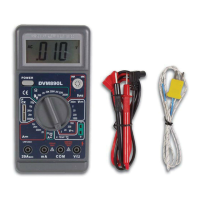DVM890L GB 1
DVM 890L
LCD Standard Digital Multimeter
1. Introduction
This instrument is a compact, rugged, battery-operated hand-held 3 1/2 digit digital multimeter for
measuring DC and AC voltages, DC and AC current and resistance. It also offers the possibility of
executing continuity tests and of testing diodes and transistors. You can also measure capacitance
and temperatures.
The Dual-Slope A/D Converter uses C-MOS technology for auto-zeroing, polarity selection and
overrange indication. Full overload protection is provided. It is an ideal instrument for use in the
field, for laboratories and workshops, for hobby and home applications.
1.1 Features
* Push-button ON/OFF power switch
* 30 different positions on the user-friendly rotary switch for FUNCTION and RANGE
* High sensitivity : 100µV
* Automatic overrange indication with the "1" displayed
* Automatic polarity indication on DC ranges
* All ranges fully protected
* Resistance measurements 0.1Ω to 200MΩ
* Capacitance measurements 1pF to 20µF
* Diode testing with 1mA fixed current
* Transistor hFE test with Ib = -100µA
* Temperature measurement with or without K type thermocouple
1.2 A word about safety
This multimeter is designed to ensure the safest operation possible. However, safe operation
depends on you, the operator. Make sure you follow these simple safety rules :
• Never apply a voltage to the multimeter that exceeds the specified limits. Never apply more than
1000V DC or 700V rms AC between an input jack and ground.
• Use extreme caution when working with voltages above 60V DC or 30V AC rms.
• Always discharge the filter capacitors in the power supply circuit under test before attaching any
test leads.
• Never connect to a voltage source when selecting DCA, ACA, resistance measurement or the
continuity check function.
• Always turn off the power and disconnect the test leads before replacing the batteries or fuse.
• Never operate the multimeter unless the battery cover is in place and fully closed.
When carrying out measurements on TVs or switching power circuits, always remember that
there may be high amplitude voltage pulses at test points which may damage the meter.

